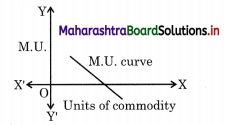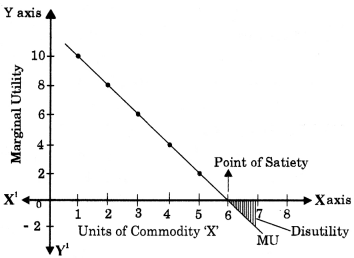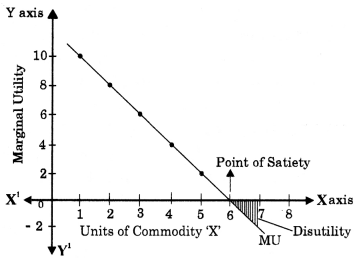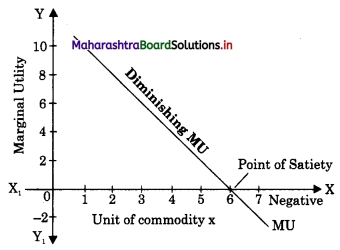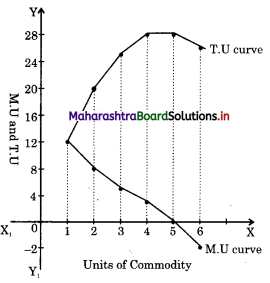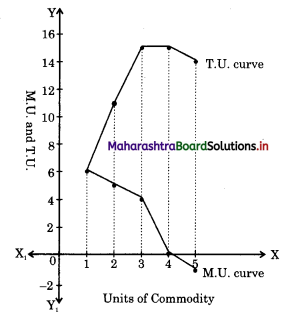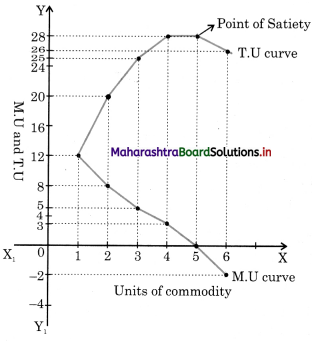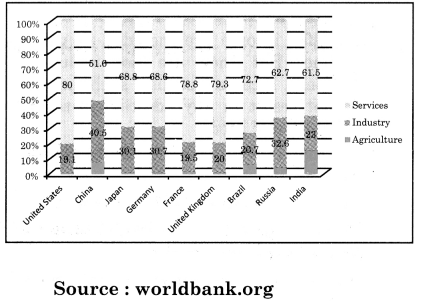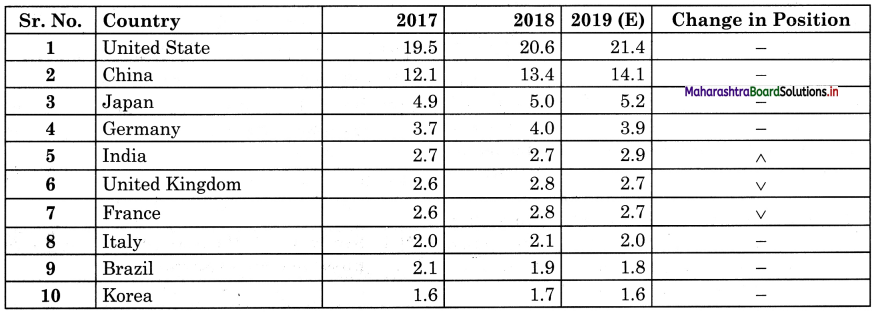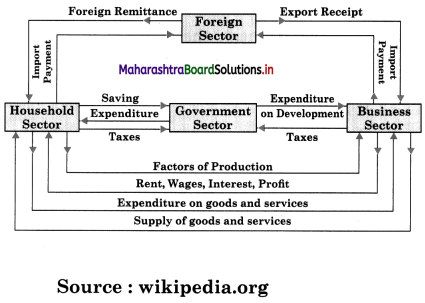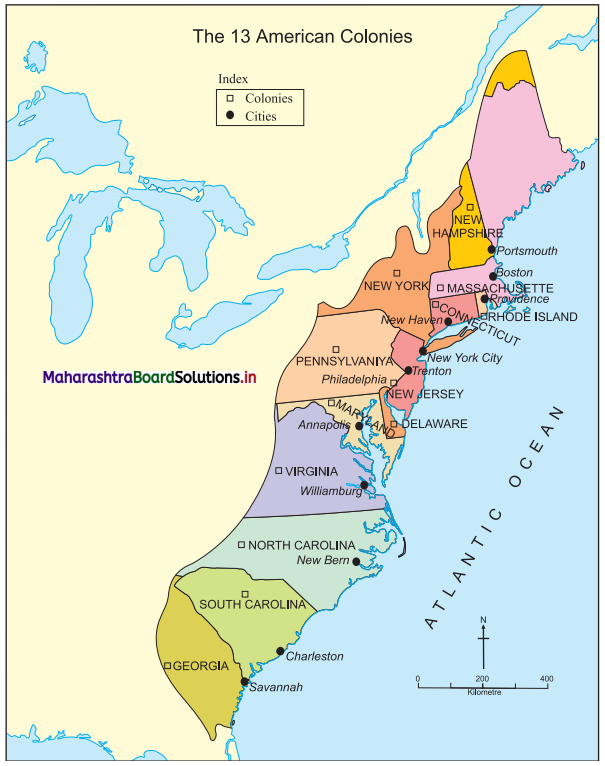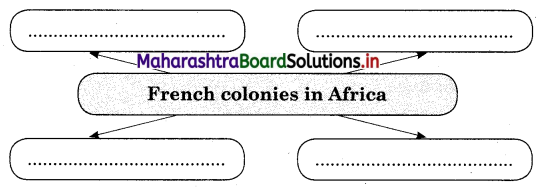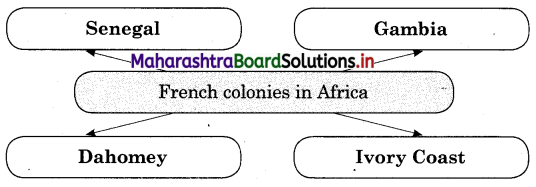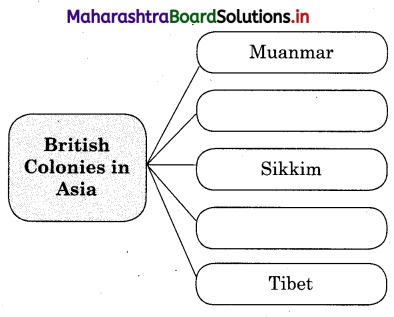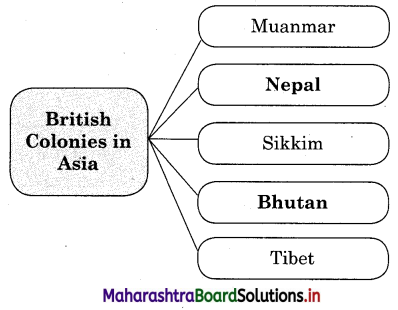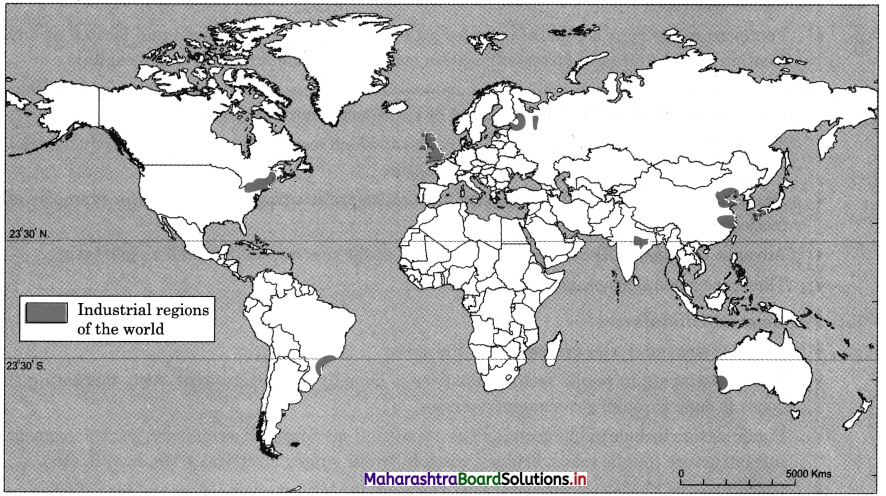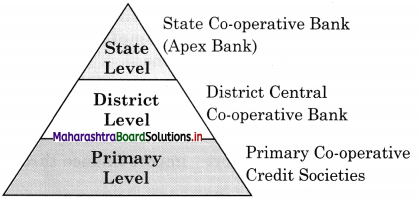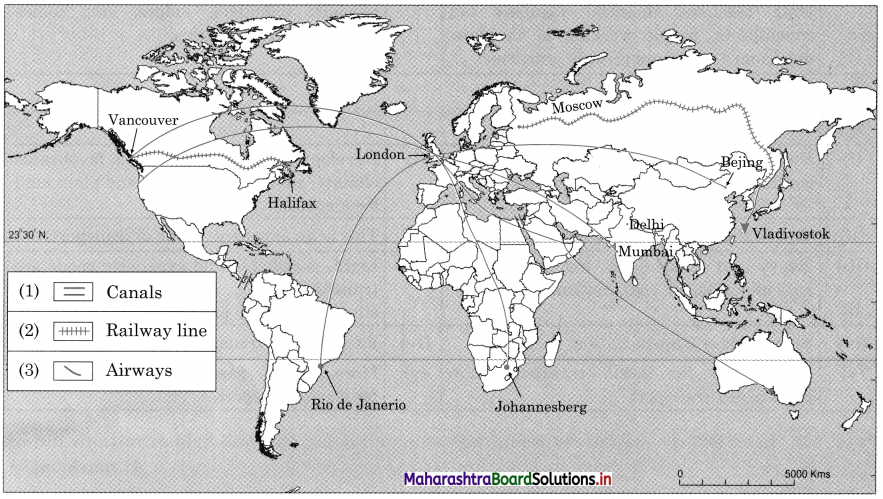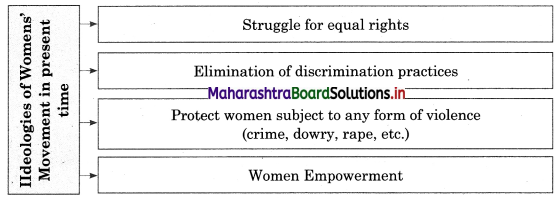Balbharti Maharashtra State Board Class 12 History Important Questions Chapter 11 India Transformed Part 1 Important Questions and Answers.
Maharashtra State Board 12th History Important Questions Chapter 11 India Transformed Part 1
1A. Choose the correct alternative and rewrite the statement.
Question 1.
On 1st January 1995, 123 nations together founded an organisation known as ____________
(a) United Nations Organisation (UNO)
(b) World Trade Organisation (WTO)
(c) SEATO
(d) I.C.A.R.
Answer:
(b) World Trade Organisation (WTO)
Question 2.
In 1998, with a view to provide support to farmers in difficult times, ____________ plan was started.
(a) Kisan Credit Card
(b) Kisan Housing Plan
(c) Kisan Employment Card
(d) National Farmer’s Bank
Answer:
(a) Kisan Credit Card
![]()
Question 3.
Under ____________ scheme, each family in rural areas was given assurance of at least 100 day’s work.
(a) Agriculture and Livestock Scheme
(b) Pradhan Mantri Peek Vima Yojana
(c) Jawahar Gram-Samruddhi Yojana
(d) Rashtriya Gramin Rojgar Hami Yojana
Answer:
(d) Rashtriya Gramin Rojgar Hami Yojana
Question 4.
____________ ranks the first in fish production while ____________ ranks the second.
(a) China, Turkey
(b) India, China
(c) India, Brazil
(d) China, India
Answer:
(d) China, India
Question 5.
The Government of India, knowing the importance of having roads in good conditions in the interior areas, started ____________ in 2000.
(a) Pradhan Mantri Gram Sadak Yojana
(b) National Highway Plan
(c) Golden Quadrilateral
(d) Metro Railway
Answer:
(a) Pradhan Mantri Gram Sadak Yojana
Question 6.
The 11th conference of BRICS was organised in ____________
(a) India
(b) China
(c) Brazil
(d) South Africa
Answer:
(c) Brazil
Question 7.
In 2008, India launched ____________ the first lunar probe.
(a) Aaryabhatt I
(b) Chandrayaan 1
(c) Mangalyan
(d) Earth 2
Answer:
(b) Chandrayan 1
Question 8.
In 1946, ‘United Nations’ declared the ____________ to be the fundamental human right.
(a) Right to Information
(b) Right to Freedom
(c) Right to Speech and Expression
(d) Right to Mercy
Answer:
(a) Right to Information
Question 9.
In 1990, ____________ started the movement called as ‘Majdoor Kisan Shakti’.
(a) Medha Patkar
(b) Arimdhati Roy
(c) Aruna Roy
(d) L.K. Kulwal
Answer:
(c) Aruna Roy
![]()
Question 10.
In 2001, ____________ started a movement in Maharashtra in support of ‘Right to Information’ Act.
(a) Anna Hazare
(b) Rahi Sarnobat
(c) Aruna Roy
(d) Arvind Kejriwal
Answer:
(a) Anna Hazare
Question 11.
The state of Jammu-Kashmir and Ladakh was given a special status by ____________ of the Constitution of India.
(a) Article 356
(b) Preamble
(c) Article 375
(d) Article 370
Answer:
(d) Article 370
Question 12.
In 1947, ____________ established ‘Jammu Praja Parishad’ party.
(a) Prem Nath Dogra
(b) Dr. Shyama Prasad Mukherjee
(c) Omar Abdulla
(d) Atal Bihari Vajpayee
Answer:
(a) Prem Nath Dogra
1B. Find the incorrect pair from group ‘B’ and write the corrected one.
Question 1.
| Group ‘A’ | Group ‘B’ |
| (a) Telangana | Telangana Rashtriya Samiti |
| (b) Jammu-Kashmir | Jammu Praja Party |
| (c) Jharkhand | Bhartiya Jharkhand Parishad |
| (d) Uttarakhand | Uttarakhand Parvatiya Rajya Parishad |
Answer:
Jharkhand – All India Jharkhand Party
2A. Write the names of historical places/persons/events.
Question 1.
The Director of WTO who prepared a draft for the establishment of this organisation –
Answer:
Arthur Dunkel
Question 2.
This plan was launched by merging together ‘Rojgar Aashwasan Yojana’ and ‘Jawahar Gram-Samruddhi Yojana’ –
Answer:
Sampoorna Gramin Rojgar Yojana
![]()
Question 3.
The scheme which is implemented for the economic welfare of the farmer –
Answer:
Pradhan Mantri Vima Yojana
Question 4.
The programme which was launched for massive modernisation of cities in 2005 –
Answer:
Jnnurm-Jawaharlal Nehru National Urban Renewal Mission
Question 5.
The service which changed the very nature of the Indian Postal Service –
Answer:
Speed Post
Question 6.
Its mathematical potential was enormous because of which India entered the global computer market –
Answer:
Param-10000
Question 7.
The place where India conducted underground nuclear test two times to prove its nuclear strength –
Answer:
Pokhran in Rajasthan
Question 8.
The first female scientist to be elected as the General President of the 62nd Indian Science Congress Association –
Answer:
Asima Chatterjee
Question 9.
The war which was fought between India and Pakistan over the issue of intrusion of Pakistan military forces in Ladakh –
Answer:
Kargil War
Question 10.
The name of the operation given to the Kargil War –
Answer:
Operation Vijay
![]()
Question 11.
The first nuclear submarine was built in India –
Answer:
Strategic Strike Nuclear Submarine of Arihant Class
2B. Choose the correct reason from those given below and complete the sentence.
Question 1.
Several plans for rural development have been implemented, so that ____________
(a) the rural sector should not get neglected and the balance between rural and urban development be maintained
(b) the rural sector becomes richer than urban areas
(c) people could donate money for the development of the rural sector
(d) rural sector becomes richer than urban sector
Answer:
(a) the rural sector should not get neglected and the balance between rural and urban development be maintained
Question 2.
Rojgar Hami Yojana was started by the ‘Ministry of Commerce and Industry of the Government of India ____________
(a) to provide employment to urban youth
(b) to give pension to the retired army personnel
(c) to assure daily wages to the unemployed agricultural labourers
(d) to increase the employment rate in tribal areas
Answer:
(c) to assure daily wages to the unemployed agricultural labourers
Question 3.
The Government of India established a separate ‘Ministry of Disinvestment’ ____________
(a) to give credits to private firms
(b) to show sympathy towards private firms
(c) to invest more money in the government sector
(d) to take care of its disinvestment policy, i.e. the gradual withdrawal of governmental investment in the public sectors
Answer:
(d) to take care of its disinvestment policy, i.e. the gradual withdrawal of governmental investment in the public sectors
3. Complete the following concept map.
Question 1.
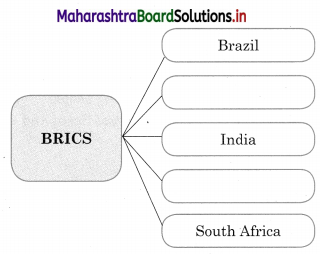
Answer:
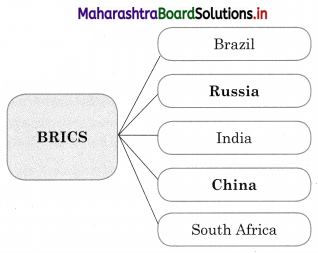
Question 2.
| Name of the State | Date of Formation |
| 1. …………………. | 1st November 2000 |
| 2. Uttarakhand | ………………………… |
| 3. …………………. | 15th November 2000 |
| 4. Telangana | …………………………. |
| 5. Jammu-Kashmir | 31st October 2019 |
| 6. Ladakh | …………………………. |
Answer:
| Name of the State | Date of Formation |
| 1. Chhattisgarh | 1st November 2000 |
| 2. Uttarakhand | 9th November 2000 |
| 3. Jharkhand | 15th November 2000 |
| 4. Telangana | 2nd June 2014 |
| 5. Jammu-Kashmir | 31st October 2019 |
| 6. Ladakh | 31st October 2019 |
4A. Write short notes.
Question 1.
BRICS
Answer:
- This organisation was established in 2006. Its name is formed by adopting the first letter of the names of the participant countries. The participant members are Brazil, Russia, India, China, and South Africa.
- This organisation was established with an aim of enhancing trade among these countries.
- The 11th conference of BRICS was organised in Brazil. The theme of this conference was ‘Economic Growth for an Innovative Future’.
- Subjects like technological co-operation, technology, and innovation, digital economy, international crime, financial scams were discussed.
![]()
Question 2.
GATT
Answer:
- During the times of the Second World War, many countries had adopted the policy of imposing various duties and taxes on imported goods, with a view to protecting their home markets.
- It resulted in declining in trade. A meeting was called in Cuba to discuss this problem, which was attended by 56 nations.
- It was decided to establish a permanent organisation to resolve the problems related to international trade. A legal agreement was signed by 23 nations on 30th October 1947, which is known as GATT. This agreement was the first multinational trade agreement.
- GATT gave priority to economic development through production and trade, to treat the member nation as ‘most favoured nation’.
- An annual meeting of the member countries of GATT used to be held in Geneva. It was attended by the representative of the member countries.
- Each country is entitled to one vote. Problems faced by individual nations regarding the difficulties of international trade were discussed in the meeting and the decision was based on these discussions.
- Later GATT became a part of the ‘World Trade Organisation’.
Question 3.
World Trade Organisation
Answer:
- On 1st January 1995, 123 nations together founded an organisation with the objective of opening the world for free trade. It was called World Trade Organisation (WTO). It’s a global trade organisation and India is a member of it.
- Arthur Dunkel, the Director-General of WTO, prepared a draft which has been fundamental to the establishment of the organisation. This draft is known as ‘Dunkel Draft’.
- The crux of this draft emphasis on trade is free from governmental custom duty and other restrictions. This approach is known as ‘liberalisation’.
- All participating countries agreed upon a set of rules and a premise common to all that would promote international trade.
- Provisions were made in the spheres of grants, exports-imports, foreign investments, reserved sectors, agriculture, technology, and the service sector.
- After becoming a member of WTO, India put a thrust on economic progress. The contribution of Prime Minister Narsimha Rao, Atal Bihar Vajpayee, and Manmohan Singh is very important in this aspect.
- The report published in 2006 has made a special mention of the increasing economic growth rate of India.
Question 4.
VVPAT
Answer:
- VVPAT means Voter Verified Paper Audit Trail.
- The Government of India started using this machine for the Nagaland Assembly Election in 2011.
- Since 2019, this device has been widely used for the Lok Sabha elections. The slip generated by the machine can be checked to determine whom you voted for.
- The voter sees the slip a few seconds after the vote. The voter can confirm his or her own vote through this machine.
Question 5.
Indian Science Congress Association.
Answer:
- This association was established on 15th January 1914 with the objective of promoting the scientific environment in India and publishing dissertations, research papers, and periodicals.
- In 1975, Asima Chatterjee became the first female scientist to be elected as the General President of the 62nd Indian Science Congress Association.
![]()
Question 6.
Speed Post
Answer:
- The Indian postal department started the service of speed post in 1986 which changed the nature of post service.
- This service was used by the majority of Indians, more than three crore letters and parcels were delivered from this service.
- The customer will get the message of successful delivery of their items.
- The postal department now offers courier services like passport delivery, business parcels, cash-on-delivery, logistics posts, and air freights.
- The post office even offers a packaging service. Over one lakh and fifty thousand post offices are offering the services like paying bills, sending festive cards and other objects.
- Since 2016, the postal department has started service of delivering Ganges water from Rishikesh and Gangotri at personal addresses.
- Buying personalized postage stamps with personal photographs and special schemes for philatelists are also available at ‘Post Shops’ opened at 80 post offices.
4B. Explain the following statements with reasons.
Question 1.
The service of ‘Speed Post’ changed the very nature of the Indian Postal Service.
Answer:
- The service of ‘Speed Post’ was started by the Indian Postal Department’ in 1986. Many people take advantage of this service, to the tune of more than three crores of letters and parcels is being delivered every month.
- The postal department sends a message of successful delivery on the mobile phone of the sender. This facility has made the speed post service more reliable.
- In addition, the postal department now offers courier services like delivery of passport, business parcel, cash-on-delivery, logistics post, and air freights.
- Now the post office offers the packaging service at an extra charge. This has increased the business of the postal department.
- It also offers services like paying various bills, sending festive greetings cards, and similar objects. The postal department has started a very novel service since 2016 of delivering Ganges water (Ganga Jal) at personal addresses from Rishikesh and Gangotri.
- Along with its facilities like buying personalized postage stamps with a personal photograph, buying newly issued postage stamps at philatelic centers, special schemes for philatelists are available at ‘post-shops’ opened at 80 post offices.
- Special limited issues of artistic postal stamps are published by the postal department in order to fulfill the requirement of philatelists.
- In this way, the service of speed post changed the very nature of the Indian postal service.
5. Answer the following questions in detail.
Question 1.
Explain India’s progress in the field of science and technology.
Answer:
- A supercomputer named ‘Param-8000’ was created with the help of C-DAC (Centre for Development of Advanced Computing, Pune. In 1998, an advanced version of ‘Param-8000’ was made which was named ‘Param-10000’.
- Its mathematical potential was enormous because of which India entered the global computer market. In 1999, India created a further version of ‘Param-10000’ which was named ‘Parampadma’. In 2003, ‘Parampadma Super Computer’ was dedicated to the nation.
- The central government’s favourable policies for the software industry, the foresightedness of Indian entrepreneurs, the nationwide spread of computer and information technology, computer engineers who are proficient in the use of the English language resulted in an increase in the Indian export of software.
- In 1995, internet services began in India. In 2004, Tata Consultancy Services was the biggest firm in Asia providing software services. Pune and Bengaluru were developed as IT hubs. Indian IT engineers are great in demand all over the world.
- In the field of science, to prove its nuclear strength, India conducted an underground nuclear test. The Indian satellite, ‘Oceansat-1’ launched and entered orbit in 1999.
- In 2000, ‘Bharat Sanchar Nigam Ltd’ (BSNL) was established to provide services like mobile phones, internet, and broadband.
- In this way, India achieved lots of progress in the field of science and technology.
![]()
Question 2.
Explain different Government schemes related to agriculture.
Answer:
According to the 2011 census, nearly 54% of India’s population is related to agriculture and agro related sector. The Government of India introduced different schemes for the progress of the agricultural sector, these schemes are as follows:
- The ‘Soil Health Card’ aims at increasing soil fertility and agricultural production.
- Pradhan Mantri Krishi Sinchan Yojana started for giving priority to water supply and irrigation facilities.
- Krishi Vikas Yojana aims at organic cultivation and increases farmer’s income.
- Pradhan Mantri Vima Yojana is implemented for the economic welfare of farmers and given the emphasis on animal husbandry, fisheries, agriculture research, and education. It also focuses on developing agriculture, co-operative establishment, and work for farmer’s welfare.
- In 2007, a national policy for farmers was adopted. If there is crop failure because of things like natural calamities, epidemics, or adverse climate, the farmers get compensated through Pradhan Mantri Peek Vima Yojana.
- Research Institute of Agricultural Sciences is supported through Indian Council for Agricultural Research. Agricultural exhibitions are organized for farmers.
- Indigenous seeds and indigenous breeds of cattle and poultry farming of indigenous variety is given priority. Goat keeping (Sheli Palan) is encouraged as an occupation.
- The ‘National Livestock Mission’ was established in 2014-15 and since then there is a rapid growth in the agricultural sector. India ranks second in fish production after China ranks first.
6. Answer the following question with the help of the given points.
Question 1.
Explain the achievement of India in the defense field.
(a) Operation Vijay
(b) Modernisation of Indian army
(c) Make in India
(d) Practice session with different countries
Answer:
(a) Operation Vijay: In 1999, Pakistan intruded Kashmir. This intrusion started a war between India and Pakistan. This war was fought in the Kargil-Drass area in Ladakh. Hence, it is known as the “Kargil War.” It is also referred to as ‘Operation Vijay’ by the Indian army. ‘Operation Vijay’ was successful and India emerged victorious in it.
(b) Modernisation of the Indian army:
- This war alerted the Indian authorities for the modernization of the Indian military. The process of updating the military, equipment, and arms, training, etc. were further intensified.
- India is the sixth country in the world to develop indigenous technology for building nuclear submarines. In 2009, India successfully built a ‘Strategic Strike Nuclear Submarine’ of the ‘Arihant class’ with the help of Russia.
![]()
(c) Make in India:
- The Government of India emphasized indigenous technology (Make in India) on recruiting women officers in the military and also on combined exercise with militaries of other countries. Women can join eight sections of the Indian army through Union Public Service Commission.
- There is an increasing focus on the exchange of the latest technology, to fight terrorism, augment our own competencies, and optimum use of modern technology for ending terrorism.
(d) Practice session with different countries: The practice session and exercise with the armies of different countries were arranged to fight terrorism. The exercise with the Oman military, Mongolian army, Sri Lankan army, and Russian army was arranged.
Question 2.
Explain the reorganization process of the states.
(a) Chhattisgarh
(b) Uttarakhand
(c) Jharkhand
(d) Telangana
(e) Jammu-Kashmir and Ladakh
Answer:
In 2000, new states were formed for the first time in India after the formation of lingual states in India.
(a) Chhattisgarh:
- Indian National Congress first put forward the demand for Chhattisgarh before independence but it was rejected by Fazal Ali Commission.
- The proposal of creating a separate state of Chhattisgarh was passed in the session of the Legislative Assembly of Madhya Pradesh in 1998.
- The state of Chhattisgarh was created by the initiative of the Government of India on 1st November 2000.
(b) Uttarakhand:
- Since 1930, the people of Garhwal and Kumaon were demanding a separate state.
- This demand was supported in the 1938 session of the Indian National Congress, however, Fazal Ali Commission ruled it out.
- The people started a movement for their demand in 1957. They also formed ‘Uttarakhand Parvatiya Rajya Parishad’ in 1973.
- In 1994, the people’s movement got intensified, hence, in recognition of popular sentiments, a bill was passed by Uttar Pradesh Legislative Assembly.
- The state of Uttaranchal, later renamed Uttarakhand, was formed on 9th November 2000.
(c) Jharkhand:
- In the year 1929, the demand for the separate state of Jharkhand was staged for the first time. It got intensified after the formation of the All India Jharkhand Party in 1947.
- An appeal was presented to the President and Prime Minister in 1973. The Bihar Legislative Assembly passed the bill ‘Jharkhand Area Autonomous Council’ in 1973. (JAAC).
- A bill providing for the division of Bihar and the creation of a separate state of Jharkhand was passed in the lower house of the parliament in August 2000 and accordingly, on 15th November 2000, a separate state of Jharkhand came into existence.
(d) Telangana:
- The state of Telangana was earlier an integral part of the state of Andhra Pradesh. A movement was started by ‘Telangana Rashtriya Samiti’ for the creation of a separate Telangana.
- In 2001, the Government of India announced the decision of the separate state of Telangana.
- The Parliament approved this demand in 2014 and on 2nd June 2014, the separate state of Telangana was formed.
![]()
(e) Jammu-Kashmir and Ladakh:
- Article 370 of the Indian Constitution gave a special status to the state of Jammu and Kashmir. In 1947, Prem Nath Dogra established the ‘Jammu Praja Parishad’ party. The motto of this party changed from ‘Ek Vidhan, Ek Pradhan, Ek Nishan’ to ‘Ek Desh me Do Vidhan, Do Pradhan, Do Nishan, Nahi Chalenge, Nahi Chalenge.
- This party demanded complete accession of Jammu-Kashmir to India but the party in power, National Conference rejected the demand.
- Dr. Shyama Prasad Mukherjee supported the demand for a complete merger. Recently in August 2019, the Government of India revoked article 370.
- From 31st October 2019, the state of Jammu and Kashmir was reconstructed as two separate Union Territories of Jammu-Kashmir and Ladakh.

